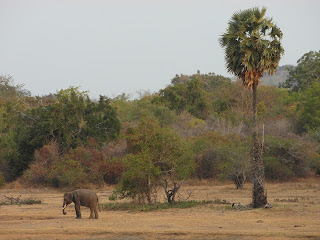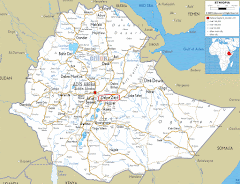Our first encounter with an elephant was while traveling from
Colombo to Mihintale some months back.
From out of nowhere—the jungle, actually—a large elephant appeared at
the side of the road. The taxi driver
stopped the car, and we watched, amazed at this huge creature just standing
there.
Until a few days ago, we had not seen rain since April—six months
to be exact. The dry zone, where we
live, is indeed dry. We have been
longing for the skies to open up and pour down their waters. The elephants, also, have been anxious for
rain. During the dry season, elephants
in Sri Lanka leave the jungles where they live and wander about in search of
food, mostly plants. While we knew this
was the case, it was still stunning for Bob to wake up at 1:00 a.m., and hear
what had to be an elephant crashing around right outside our bedroom
window. Bob’s broken leg did not allow
him to get up and investigate, and because I was recovering from our accident also,
he did not wake me. The next day our landlords asked if we had heard the elephant.
They showed me the ten banana trees
which had been crushed to the ground by the night-time visitor, none too happy about this
destruction of a vital food source.
A few weeks later, our landlords called and said, “There are
elephants at the lake. Let’s go see them!” So we drove a couple miles down the road and,
along with the throngs of other elephant gazers on their way home from work, we
watched 15 or so elephants in the distance, maybe a quarter of a mile away,
roaming around, munching on whatever they could find. They were mesmerizing.
Not long ago, another elephant visited our back yard, this
time at 4:00 a.m. Bob was becoming more
mobile by then, so he hobbled with his crutches to the balcony outside our
second-floor bedroom. Together we
listened to the sound of an elephant walking, breathing, tramping around. It was too dark to take photos, but we tried
anyway. A few minutes later, the
elephant trudged off, and the sounds became fainter, more distant. In the morning, our landlords were even more
distraught than before. This time the
elephant had downed two coconut trees—elephants eat the leaves and part of the
bark from the inside. In order to get to
the leaves, which are up high, they have to tear down the whole palm. Coconuts are a staple in Sri Lankan cooking—our
landlords use one every day. They have
plenty of trees, but what if their whole lot is flattened? They made large campfires every night to
prevent the elephants from coming.
Even though elephants do attack property and people in Sri Lanka, they are a beloved creature, seen at many festivals. Yet the Sri Lankan elephant, one of three varieties of Asian elephants, is an endangered species. They have been threatened by poachers and, during the war, were killed by land mines and gun shots. About 100 wild elephants a year are killed to protect crops and houses, while others are threatened by deforestation, drought, and starvation. The elephant refuge, which I visited in May, is home to about 80 injured or orphaned elephants. Their grazing on the hillside and bathing in the river is enchanting.












Wow! The thought never came to my mind that elephants could be so destructive! Great photos, too :)
ReplyDelete